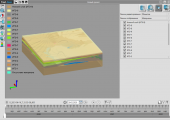Project summary

The customer had a CAE system intended to carry out thermal calculation of soil behavior. As part of this project, the customer needed to make a separate software product for calculating the bearing capacity of pile foundations based on the existing thermal calculation.
The principle of Frost. Pile operation is as follows: a model with the results of thermal calculation of soils is uploaded in it, after that, a pile foundation is added to the 3D scene, operating conditions are set, and the user gets the calculated bearing capacity at specified points of time.
The product is intended primarily to make the calculation activities of design organizations automated. A full calculation of pile foundations according to building standards was implemented in the project.
The extremely complex product with a huge amount of functionality was not covered with autotests. Changes in one place caused bugs in other places, which made it difficult to build up new functionality. The customer could not be sure of the quality of each delivery due to a large number of bugs in the product. Releases were carried out once a year with delays of up to 4 months. The rarely updated product was not always able to meet the needs of end users in a timely manner.
Technical description of the project
The software module consists of the following parts:
- Data import module – imports data from the main system.
- Calculation module – calculates the bearing capacity.
- 3D scene – allows to visualize the results of calculations in the form of a 3D model.
- Data storage module – allows setting and storing all parameters of the system influence.
- Report generator – allows uploading the calculation data to a special report.
The project is a desktop application written in C# using WPF technology.
JazzTeam responsibilities
Within this project, JazzTeam was responsible for project management and quality assurance.
Project management
JazzTeam was required to manage the following key project processes:
- Research reports:
- Determination of Vision & Scope of the project.
- Creation of the application structure and data flow.
- Creation of the architecture and algorithms of the calculation module.
- Development:
- Development of the calculation module.
- 3D engine implementation.
- Development of data import, data storage and processing, and a report generator.
- Implementation of hardware protection.
- Quality assurance:
- Unit and integration testing.
- DDT testing of the calculation module.
- Manual testing.
- Release management.
Quality assurance
JazzTeam was responsible for quality assurance as part of this project. Tasks were set for all team members:
- developers;
- business analysts;
- testing engineer.
When writing code, developers immediately performed unit and integration testing. Taking into account the existing CI/CD system, this helped to significantly reduce the number of bugs that are revealed during manual testing, as well as ensure the required level of quality during development. Four developers were working on the module at a time, so the culture of writing automated tests greatly simplified collaboration.
Business analysts prepared data for calculation module testing – in total, about 270,000 test checks were created for various components of the calculation module using a third-party product, after which these checks as part of the Data Driven Testing approach were performed within the Continuous Integration approach. This made it possible to greatly reduce the likelihood of bugs in the calculation module.
Manual testing was performed in three stages – checking the task set, functional testing and pre-release full regression testing.
Project technologies
Platform: C#, .NET.
Technologies: WPF, 3D Engine, DDT, CI/CD, TestLink.
Processes: test management, project management, release management.
Project results
The calculation module, which allows calculating the bearing capacity of pile foundations on the basis of a finished modeled physical object.
This project allowed the customer to significantly expand its presence in the market of calculation programs for modeling buildings and structures built in permafrost zones.
Company’s achievements on the project
- Project management, as a result of which a product was made in six months, which is a CAE system with an unconventional calculation module and 3D visualization implemented.
- Completely changed organizational approach of the team to the development of a new project:
- cross-functional team;
- incremental approach during development;
- two-stage code review – each change to the master branch was reviewed by two developers and pre-checked by autotests;
- all the rituals of the scrum framework.
- Detailed testing of the calculation module using the Data Driven Testing approach.
Screenshots
Clients about cooperation with JazzTeam
















